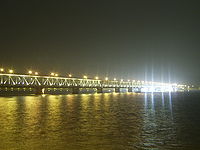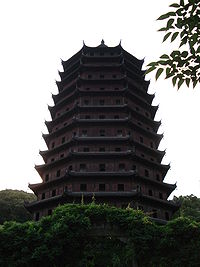
Qiantang River
Encyclopedia


China
Chinese civilization may refer to:* China for more general discussion of the country.* Chinese culture* Greater China, the transnational community of ethnic Chinese.* History of China* Sinosphere, the area historically affected by Chinese culture...
river
River
A river is a natural watercourse, usually freshwater, flowing towards an ocean, a lake, a sea, or another river. In a few cases, a river simply flows into the ground or dries up completely before reaching another body of water. Small rivers may also be called by several other names, including...
that originates in the borders of Anhui
Anhui
Anhui is a province in the People's Republic of China. Located in eastern China across the basins of the Yangtze River and the Huai River, it borders Jiangsu to the east, Zhejiang to the southeast, Jiangxi to the south, Hubei to the southwest, Henan to the northwest, and Shandong for a tiny...
and Jiangxi
Jiangxi
' is a southern province in the People's Republic of China. Spanning from the banks of the Yangtze River in the north into hillier areas in the south, it shares a border with Anhui to the north, Zhejiang to the northeast, Fujian to the east, Guangdong to the south, Hunan to the west, and Hubei to...
provinces and passes through Hangzhou
Hangzhou
Hangzhou , formerly transliterated as Hangchow, is the capital and largest city of Zhejiang Province in Eastern China. Governed as a sub-provincial city, and as of 2010, its entire administrative division or prefecture had a registered population of 8.7 million people...
, the capital of Zhejiang
Zhejiang
Zhejiang is an eastern coastal province of the People's Republic of China. The word Zhejiang was the old name of the Qiantang River, which passes through Hangzhou, the provincial capital...
province, before flowing into the East China Sea
East China Sea
The East China Sea is a marginal sea east of China. It is a part of the Pacific Ocean and covers an area of 1,249,000 km² or 750,000 square miles.-Geography:...
through Hangzhou Bay
Hangzhou Bay
Hangzhou Bay, or the Bay of Hangzhou , is an inlet of the East China Sea, bordered by the province of Zhejiang and the municipality of Shanghai. The Qiantang River flows into the bay.It lies south of Shanghai, and ends at the city of Hangzhou...
.
The lower stream of Qiantang River is known as Fuchun (富春) River, 285 mi (459 km) long in Zhejiang
Zhejiang
Zhejiang is an eastern coastal province of the People's Republic of China. The word Zhejiang was the old name of the Qiantang River, which passes through Hangzhou, the provincial capital...
province. An important commercial artery, it flows NE to the East China Sea
East China Sea
The East China Sea is a marginal sea east of China. It is a part of the Pacific Ocean and covers an area of 1,249,000 km² or 750,000 square miles.-Geography:...
at Hangzhou
Hangzhou
Hangzhou , formerly transliterated as Hangchow, is the capital and largest city of Zhejiang Province in Eastern China. Governed as a sub-provincial city, and as of 2010, its entire administrative division or prefecture had a registered population of 8.7 million people...
.
The First Qiantang River Bridge in Hangzhou was the first steel bridge to span across a major river in China when it was built in the 1930s.
The river is also the southern terminal of the ancient Grand Canal
Grand Canal of China
The Grand Canal in China, also known as the Beijing-Hangzhou Grand Canal is the longest canal or artificial river in the world. Starting at Beijing, it passes through Tianjin and the provinces of Hebei, Shandong, Jiangsu and Zhejiang to the city of Hangzhou...
that links five major rivers in China from north to south, enabling traffic north to Beijing
Beijing
Beijing , also known as Peking , is the capital of the People's Republic of China and one of the most populous cities in the world, with a population of 19,612,368 as of 2010. The city is the country's political, cultural, and educational center, and home to the headquarters for most of China's...
from Hangzhou via the Canal.
The Qiantang was previously known under the names Zhe River (Zhejiang
Zhejiang
Zhejiang is an eastern coastal province of the People's Republic of China. The word Zhejiang was the old name of the Qiantang River, which passes through Hangzhou, the provincial capital...
, 折江,"crooked river"), Luocha River, or Zhi River. It was re-named "Qiantang" (literally "Qian's pond") in honour of the kings of Wuyue
Wuyue
Kingdom of Wuyue , 907-978, was a small independent coastal kingdom founded during the Five Dynasties and Ten Kingdoms of Chinese history. It was ruled by the Qian family, which remains widespread in the kingdom's former territory.-Founding:...
(907-978), whose extensive hydro-engineering schemes in large part ensured the prosperity of the region in later centuries.
Tidal bore
The river and bay are known for the world's largest tidal boreTidal bore
A tidal bore is a tidal phenomenon in which the leading edge of the incoming tide forms a wave of water that travel up a river or narrow bay against the direction of the river or bay's current...
, which is up to 9 metres (30 ft) high, and travels at up to 40 km per hour (25 miles an hour). The tide rushing into the river from the bay causes a bore usually from 5 to 15 ft (1.5–4.6 m) high, which sweeps past Hangzhou
Hangzhou
Hangzhou , formerly transliterated as Hangchow, is the capital and largest city of Zhejiang Province in Eastern China. Governed as a sub-provincial city, and as of 2010, its entire administrative division or prefecture had a registered population of 8.7 million people...
and menaces shipping in the harbor. It is so dangerous that, until recently, no one attempting to surf
River surfing
River surfing is the sport of surfing either standing waves or tidal bores in rivers. Claims for its origins include a 1955 ride of 1.5 miles along the tidal bore of the River Severn...
it has managed to remain upright for more than 11 seconds.
In September 2008 a group of American surfers convinced the Chinese government to allow them to surf a section of the river. Personal watercraft were used to safely transport the surfers in and out of the tidal bore.

